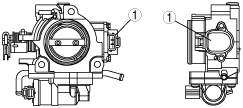 |
am3zzn00000385
THROTTLE POSITION (TP) SENSOR CONSTRUCTION/OPERATION[ZJ, ZY, Z6]
id0140b1174000
Without Throttle Valve Actuator
am3zzn00000385
|
|
1
|
TP sensor
|
am3zzn00000386
|
|
1
|
TP sensor
|
|
2
|
Throttle position sensor voltage characteristic
|
|
3
|
Throttle opening angle
|
|
4
|
Output voltage
|
|
5
|
Small
|
|
6
|
Large
|
|
7
|
Fully-closed
|
|
8
|
Fully-open
|
With Throttle Valve Actuator
am3zzn00001025
|
|
1
|
Valve body
|
|
2
|
Throttle valve
|
|
3
|
TP sensor
|
TP Sensor Voltage Characteristics
am3zzn00001026
|
|
1
|
APP sensor
|
|
2
|
Hall element sensor
|
|
3
|
Magnet
|
|
4
|
Main sensor
|
|
5
|
Sub-sensor
|
|
6
|
Accelerator pedal depression amount
|
|
7
|
Output voltage
|
|
8
|
Large
|
|
9
|
Small
|
|
10
|
High
|
|
11
|
Low
|